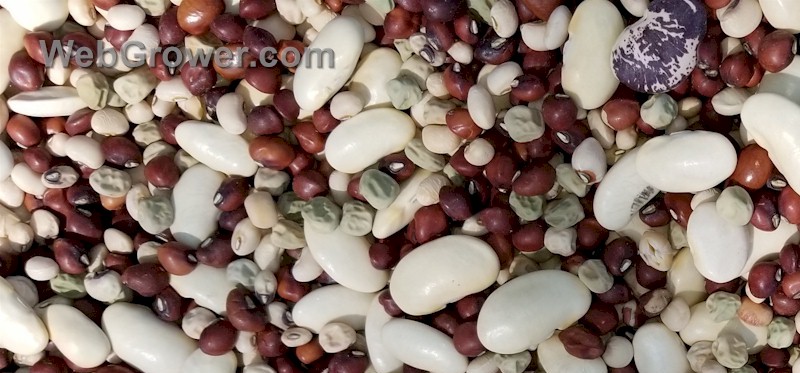Homepage → Gardening Related Topics → A Case for Gardening with Heirloom Plants
A Case for Gardening with Heirloom Plants
Planted July 27, 1999
Last tended to on October 14, 2024
Reading time: 4 minutes

by Mike Dunton
I. A Historical Background
When humans ceased relying on nature for sustenance and began to raise their own food, agriculture was born. These first farmers began domesticating wild animals for work, companionship, and for food. They also began a process of selecting plants with specific, desirable traits thus developing new plant varieties.
For eons, societies have been agrarian at their roots. Farming practices evolved, but generally remained grounded in the dynamics of nature. Our ancestors knew their soil and their climate intimately. Their life depended on their success in the gardens and fields.
Every spring, they planted. Every summer, they cultivated. Every fall, they harvested. Every year they selected and saved their best seed for next year’s planting. And every generation passed these treasures on to the next.
As America entered the 20th century, industrialization prompted migration to the cities. The remaining farms began a spiral of consolidation and growth, increasing in size, mechanization, and efficiency.
Large seed companies that catered to farmers began to shift from standard seed varieties towards more profitable F1 hybrids. These unstable hybrids were marketed for specific traits that are beneficial to commercial farming operations, i.e. disease resistance, consistent ripening, etc. However, if the farmer were to save and plant seeds from his harvest, the resulting plants generally did not have the same characteristics of the previous or parent generation. This insured a steady cash flow for the seed companies.
Since home gardeners do not typically have the same requirements as commercial farmers, for example, crops that ripen throughout the season and not all at once, seed companies continued to provide open-pollinated (standard) varieties. These seed companies tended to be regional, supplying seeds that best suited their local clientele. Additionally, some families continued the tradition of passing along treasured varieties; what are now termed, “heirloom seeds.”
II. Threats to Biodiversity
As the 20th century progressed, the small regional seed companies began going out of business or merging and consolidating into larger, generalized companies. This consolidation often included the dropping of less profitable or similar varieties from the line of the new company. These mergers accelerated at an alarming rate through the 1970s and 1980s. Thousands of old varieties were dropped and unless they were in the holdings of the USDA seedbank or a private collection, forever lost.
Through this process, mergers and consolidations have resulted in a handful of large, international, agri-chemical conglomerates gaining control of the mainstream international seed industry and ultimately the food supply of the world [1]. The stakes are enormous both financially and politically.
These corporations are no different from any other business sector. They are driven by shareholder’s interests and motivated by the bottom line (greed) to work towards increasing their influence (power) and income (profits). As a result, new scientific technologies and processes have been used to quickly create novel, and in some cases, controllable seeds (refer to the “Terminator Technology” article). These genetically modified products are now in everything from the clothes that we wear (cotton) to the food that we eat.
Since our society has moved so far away from its agrarian roots, educating people is critically important. If we do not fundamentally understand basic biology and agricultural processes, we can only superficially grasp the gravity of the threats to our food supply and ultimately our health. It must be understood that diversity of available plant varieties is important to all of us. We must ensure that a repeat of the “Irish Potato Famine,” or more recently, “The Corn Disease Panic of 1970” never again happens.
III. Actions for Preservation
Ultimately, it is about personal choice. As consumers, we should be allowed to make our own decisions about genetically modified organisms, their benefits or threats, and whether we want them as part of our personal diet. The pro-biotechnology corporations are well funded and well connected within the leadership of governments. We must support grass-root efforts at passing laws requiring the labeling of food that contains genetically modified ingredients.
Additionally, we should work to preserve old seed varieties for future generations to enjoy. Since the 1970s, many organizations and small alternative seed companies have answered the call to help fight this erosion and have pledged to not knowingly sell genetically modified organisms.
Although many varieties have been forever lost, it is never too late to start saving what we still have. There are many ways that each person can work towards this goal. You can start by supporting the work of like-minded organizations. By gardening with open-pollinated, heirloom seeds, you can connect with our past and continue a process as ancient as our oldest recorded history. Ultimately, by using these seeds, you create and maintain a demand for them. This is perhaps the most important part of working towards saving seeds for future generations.
- "The Seed Giants: Who Owns Whom?", Seed Industry Consolidation - Update 2000, RAFI, 21 December 2000, (This document is available as a PDF file only and no very old.)
Mike Dunton is an "heirloom seed pioneer" who founded, and is the former owner of, the Victory Seed Company. As a seed professional, biodiversity preservationist, horticultural historian, technologist, farmer, gardener, homesteader, writer, and educator, he has worked for decades to share the knowledge and experience that he has gained over a lifetime of trial and error. He strives to pass down his passion for incorporating old-timey skills into our everyday, modern lives.
Copyright © 1998 - 2024 - All rights reserved
WebGrower.com℠ is a service mark of Victory Horticultural Group, LLC.
• Privacy Statement •
This site participates in the Amazon Services LLC Associates Program, an affiliate advertising program designed to provide a means for sites to earn advertising fees by advertising and linking to amazon.com.